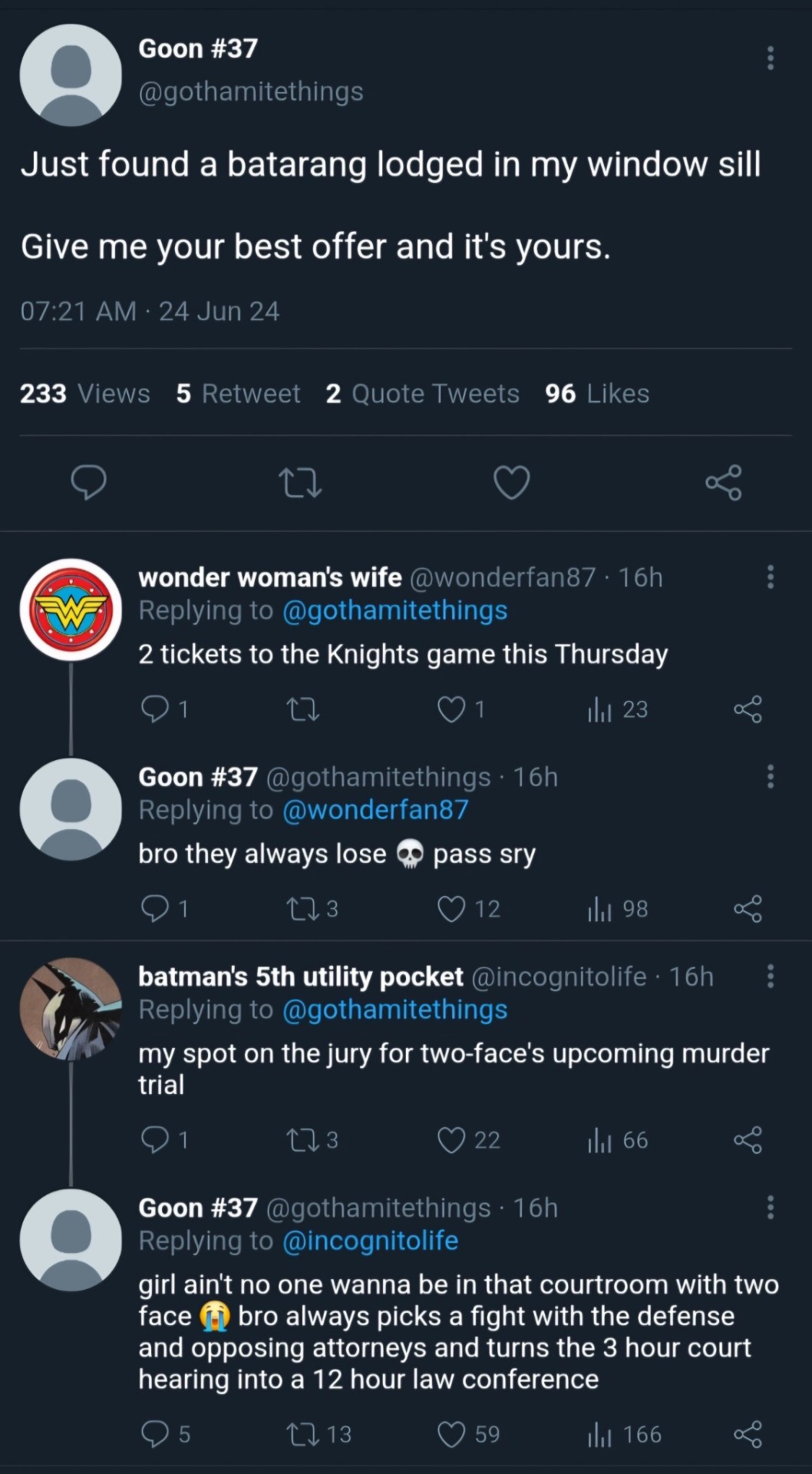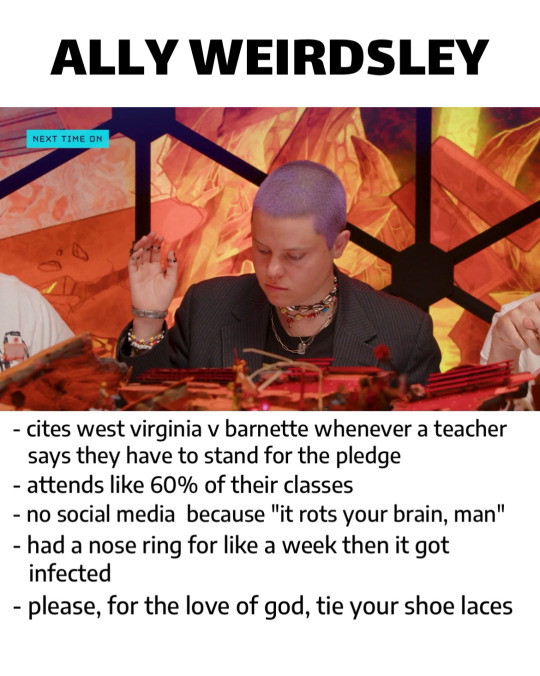#shit's getting real
Explore tagged Tumblr posts
Text
The only thing I could think of at the end of Ep 9 regarding Captain and Keen... 🍿🍿🍿

Oh Captain, my Captain... you done fucked up 👀
#playboyy#playboyy the series#captainkeen#vivit pharunrit#boat pakorn#shit's getting real#ep nine was fucking fantastic#playboyy episode 9
12 notes
·
View notes
Text

4 notes
·
View notes
Text
I find it funny that Chilchuck gets hited by rocks one extra time on anime than in manga





They really said: "yea, one more time wouldn't hurt"
#dungeon meshi#chilchuck#chilchuck tims#dunmeshi#i get what they feel#the urge to hit him with a brick is real#delicious in dungeon#my shit
21K notes
·
View notes
Text
no im not thinking constantly about the early game hilarity of when its just the ladies of da:v lounging around the dining room watching a freshly freed Lucanis bus about the stoves making food for his new strange flock of poorly fed women.
#lucanis dellamorte#datv#da:v#my rook and bellara and neve and harding just#smirking and giggling and leering and backseat cooking#the Female Gaze is real#and a soft but dangerous man with a slutty little waist and his sleeves pushed up his forearms making dinner is#probably new for them#also spite#rookanis#harding constantly elbowing my mooning rook in the ribs like#girl get your shit /together/
4K notes
·
View notes
Text

if we could stay connected, just like this
#ok last orbit niigo post im emubrained again and also i miss leoneed#project sekai#pjsk#prsk#mizuki5 spoilers#proseka#mizuki akiyama#mizu5#nightcord at 25:00#hurray !#meltdown released an amazing translation of the event so i read it and had my final cathartic transgender cry about it#and now i have ~4 assignments due on friday so i have to stop drawing mizuki. sad.#i recommend everyone watch meltdown's translation#please. its very good and better than the mtls floating around#i Get why people wanted to see it translated asap like i Get it i didnt understand half of the wordplay or kanji but like . wah#its so crazy how this event breached containment n how many people are rooting for mizuki even tho they dont play the game so i just#think its a shame that the translation everyones reading isnt really accurate/lacks the nuances.. Ok sorrynits a good event.#ive just been thinking abiut that for a few days and i love talking in tags. Adios#real Orbit heads will know this is an Heartorbit reference (that tarot card sketch i did almost 2 years ago and said i would finish)#(i havent finished shit)
4K notes
·
View notes
Text
。゚゚・。・゚゚。 ゚. December will bring blessings.
゚・。・゚
#cottagecore#december#omg it’s my birthday month#shout out to all my sags!!#sagittarius#let’s manifest this shit!#this month in particular needs a good blessing#cus it can get real weird around Christmas#blessings#positivity#manifestation#oh yeah#text#emoji#winter aesthetic#winter#heart#heartcore
5K notes
·
View notes
Text




Sketching while streaming s5...
Jonathan Sims I will learn to draw you (this is my doing. I could draw him however I want and I choose to stick with an image of him in my brain that is difficult for me to draw. Masochism.)
Not s5 Mahtins below I enjoyed drawing cuz hes neat:

(Edit: I yassified Martin in the do not separate cuz I wanted his hair fluffier)
#yes I realize Jon and Martin are in different fucking art styles let me live#do not accuse me of being AI this difficulty drawing hands is all natural I worked hard drawing for years just to fucking suck at it#update I listened to 170 I heard it was devastating but my ass was LAUGHING#poor martin but omg me and my buddy had everywhere at the end of time in the background and shit was so funny#he forgor 😭💀#it was emotionally devastating at the end tho Jon suggesting he stay there um btich NO?!#Jon the literal Lonely is not worse tham being around you get a fucking grip#helen continues to be the best character her showing up for the juicy gossip is so fucking real#anyagays#tma#tma podcast#the magnus pod#tma fanart#jonathan sims#the magnus archives#my art#martin blackwood#jonmartin#jmart#tma jmart#tma season 5#tma spoilers#i have to make a diagram for my jon and martin designs for s5 SO bad#if only i could draw jon.... >:(#i need u guys to know that my martin loves plaid and jon is wearing a plaid shirt thats too big in s5... inchresting....
4K notes
·
View notes
Text
POV: You're on Gothamtwt










just gothamite things
<- Prev Masterlist Next ->
#a person could literally explode in broad daylight & gothamites would just b like: wow crazy. anyways#ppl from other cities shit talk gothamites all the time but lets be real theyre probably the most durable kind of ppl#fucking brainiac could come down and threaten gotham & the citizens would just be like 'ok lol do ur worst'#every week u'll see a different piece of bat paraphernalia get auctioned off on twitter & the entirety of gotham treats it like a sport#social media au#dc comics#nightwing#dick grayson#barbara gordon#oracle#jason todd#red hood#stephanie brown#spoiler#damian wayne#robin#black bat#cassandra cain#batfam#batfamily#batkids#batman#bruce wayne#incorrect quotes#texts#tweets#twitter#crack#fanatical posting
6K notes
·
View notes
Text
I think one of the funniest things about the Sabzeruz event is that the devs choose to go with Candace, Traveler, and Paimon having a whole "Ooh, two mysterious men are going into an alley to have a 'private' conversation; they must be bad guys!" only to then go "Oh just kidding, it was only Alhaitham and Kaveh doing typical Alhaitham and Kaveh things."
Except the "Alhaitham and Kaveh" thing in question this time was talking about Mehrak, a sentient robot that Kaveh built using absolutely forbidden technology, and which he then whole-heartedly willed would develop a consciousness of its own, violating one of the central taboos of his nation's governing agency, committing what amounts to an inherent and extreme felony punishable by law.
Alhaitham and Kaveh: Listen, we're not bad guys discussing illegal activity here. We're just two men having a private, personal conversation. Happens all the time.
Paimon, Candace, and Traveler: Oh cool, they're not doing a crime; they're just gay.
But they were, in fact, doing a crime.
#genshin impact#alhaitham#kaveh#haikaveh#kavetham#mehrak#I still can't get over how Kaveh is friends with the chief of police#and living with the former Acting Grand Sage#and Tighnari had to completely hide Karkata's existence with ARSON to get rid of the evidence#but everyone in the entirety of Sumeru just said#ya know#let's let Kaveh have this one#and no one blinks an eye at Mehrak#who is obviously capable of reasoning and rational thought at this point#Light of Kshahrewar is truly the favorite#everyone in Sumeru has one exception#and that exception is Kaveh#let's be real#the reason no one is saying shit about Mehrak#is no one wants to deal with Scribe “I overthrow the government when people displease me” Alhaitham#bro really said “Upset Kaveh at your own peril”#“Only I'M allowed to upset him”#the last people who made Kaveh sad have been sentenced to living in caves and subsisting off mushrooms for the rest of their lives#and this was seen as mercy on Alhaitham and Cyno's part
2K notes
·
View notes
Text
kamala khan would have the most horrendous ao3 author's notes known to man
"hey guys sorry the update is late i switched places with an avenger (ajdgrhsh literally crying) and a really cool space scientist lady and then got into a fight and some alien dudes wrecked my house and then I met Nick fury and I was literal space it was crazy and I had to help save the universe and saw said scientist lady give up her life to save all of us... anyways hope you like the new fic, branching out with an arranged marriage au for this one!!!"
#rosi shitposts#marvel#mcu#the marvels#kamala khan#carol danvers#monica rambeau#ms marvel#captain marvel#the marvels spoilers#marvel spoilers#i want to read her fics#all of them are multichapters#somewhere between 5k and 10k per chapter#tries to update AT LEAST once a month#all of it is some of the best shit you've ever read#girl is insane for that and i love her#alternatively#she has so many au ideas rattling around in her brain and so many started fics but they havent been updated for at least a year#and then turns up with this AN and you know its about to get real#ao3
8K notes
·
View notes
Text

Gregory vs Cassie’s reactions to FNAF jumpscares
#myart#chloesimagination#comic#fnaf#five nights at freddy's#fnaf fanart#cassie fnaf#fnaf gregory#montgomery gator#roxanne wolf#security breach#fnaf ruin#it’s so funny how Gregory like just gets jumped#like he doesn’t fit back#he just accepts his fate#BUT CASSIE FIGHTSSS these dudes#in all her jumpscares she’s grabbing at their faces#pushing them off#gripping their teeth and shit#SHESSS NOT HAVING THISSS#AND she’s so real for that
2K notes
·
View notes
Text
Daily reminder that Astarion is pansexual. 🩷💛🩵

#astarion is pansexual#cry about it#bg3#baldurs gate 3#astarion ancunin#astarion bg3#astarion x tav#astarion#astarion my beloved#bg3 tav#getting real sick of this shit#effeminate men can like women ffs
2K notes
·
View notes
Text
HAPPY ANNIVERSARY TO THE PROREV FRERARD KISS

July 28, 2007
#17 years of getting real gay with it with the bestie onstage#17 years of frerard shit#frank iero#gerard way#my chemical romance#mcr#frerard#yeah I’ll fucking say it#ProRev#projekt revolution#prorev kiss#ProRev frerard kiss
2K notes
·
View notes
Text





Columbo and the Knight (1984)
put me in the universe where Columbo ran through the 1980s and had a crossover episode with Knight Rider. I think they deserved it, and I am not just saying that because they're my two favorite Old Shows. @telebeast wrote a little fanfic blurb about it and I HAD to visualize it into a comic (which is also the longest comic I have finished thus far at five pages...), so writing credit goes to them.
Autism W!
#columbo#knight rider#art#michael knight#kitt#comic#highlight reel#crossover#telebeast#there are two small easter eggs here. can you find them. they were somehow not Entirely lost when i resized these for the public#this is what i mean when i say I Draw And It's Everyone Else's Problem. look at my INCREDIBLY niche crossover comic boy#if the knight rider fandom has like 12 people in it. how many of y'all have seen columbo#this comic is for like 4 people and me and phoenix are already two of them#niche is my specialty lets be real. weird niche obscure shit and ships nobody's paid attention to yet#not to suggest this is ship art. columbo has his wife and michael has his car lmfao#stylizing real people is EXTREMELY hard btw sorry for when they get off model. its partly a 'better imperfect than never finished' situatio#cant tell you how much i redrew some of these panels. weeps#this took me 2 weeks but i think i thumbnailed it all in may and the ideas been rollin around in my head since march#is anybody good at editing. please edit michael and columbo into an image together like its a screenshot. NOT generated. edited.#it would be so cool#ive drawn columbo a lot but i haven't drawn a lot of michaels. i was learning things about his outfit AS I WAS DOING THE DAMN#COLORS ON THIS. all the lines done. it was too late to change anything. i did all the lines and colored page by page#i realized my mistakes on like page 3. 1 and 2 were already done. it was Too Late.#imagine it though. them working a case together. switching between the more serious tone of columbo vs the goofier#action antics of michael and kitt. columbo being so impressed by Modern Technology. there's more i could say but phoenix may write#more of this crossover and i don't want to spoil it :'3#there's opportunity here though i swear. there's gold to be dug.#i like how kitt gets shading but columbo's junker peugeot doesn't. kitt looked wrong without any. columbo's car is matte and dirty#i also applied effects to this to make it look a little film-grainy and VHS like. some CRT TV vibes#the only question left is. did they put knight rider into columbo; or columbo into knight rider 🤔
3K notes
·
View notes
Text

In the Name of the Great Life!
******
Introduction
His pure white robes contrast with the muddied waters as the white-bearded baptiser, his staff propped against him, dunks the head of the baptised into the river. It could be a biblical scene. The river is the Jordan. This could be John the Baptist immersing [Josh], [His Firewater] about to descend in the form of a dove, the voice from above about to announce that, "Thou art my beloved Son, with thee I am well pleased."
Yet it is not [Josh] who is being baptised and it is not John who is doing the baptising. I am looking at a photograph, from around 2002. This river is 'Yardna' in the dialect of Aramaic that the baptiser speaks, literally 'Jordan'. But this is not the physical and geographical River Jordan that runs through the countries of Jordan and Israel. This river is in Iraq, and it is likely to be the Euphrates. But it could be a river in New Jersey, USA, or the River Nepean running through a public park in Sydney, Australia. Every clean-running river in the entire world could potentially be the Yardna -- the Jordan -- if it is used for this purpose. Neither is this baptism a milestone event in the life of a Christian, which admits him or her into the Church. These baptisms occur every week, And these people are not Christians, Jews or Muslims. They are the Mandeans.
Keepers of an ancient minority religious tradition, victims of sectarian violence and ethnic cleansing, these peace-loving people have been fleeing to Syria and to the West and may be found in small numbers in such unlikely locations as Sydney, New Jersey or Manchester. They are among the casualties of the Western intervention in Iraq and the recent activities of ISIS. Although they are eager to blend in with their local culture and are often happy to be perceived as Christians, their religion is very distinctive, with priests (known as tarmidas) holding dramatic river baptisms in white robes. They may also lay claim to being the last Gnostics. They are the only surviving remnant of the ancient Christian-related sects who taught gnosis, the direct knowledge of God, created their own gospels and myths, and were persecuted as heretical by the Church in the 2nd and 3rd centuries. The Mandeans place these weekly river baptisms at the center of their religious life, and the most important prophet, although not the founder of their religion, is claimed to be none other than John the Baptist (Yahia the Mandaic). For this reason they became known, inaccurately, as 'St. John's Christians' to the first Westerners who encountered them.
Could this really be true? Could an obscure Middle Eastern ethnic religion really stretch all the way back to the Gnostics and John the Baptist? Surely the Gnostics -- an umbrella term for a range of heterodox religious groups known to scholars as Sethians, Valentinians and the like -- died out in antiquity, marginalized and persecuted by the Church? The medieval Cathars, generally recognised as the very last group of successors to dualistic Gnostic Christianity, were eradicated in the series of bloodthirsty massacres known as the Albigensian Crusade. How could a little-know sect in Iraq and Iran be related to heretical Gnostic groups, who had thrived in Egypt, Syria, Italy and France?
And could they really lay historical claim to John the Baptist as their prophet? All Christians know that John's role was merely as the forerunner to the Christian revelation, a function that was fulfilled once he had baptised [Josh]. John himself was beheaded by Herod Antipas before [Josh] was crucified. Surely that was an end to his story? Are we now in the realms of alternative history? In some ways, yes. Much of alternative history involves a radical reconsideration of the origins of Christianity, the validity of its transmission through the centuries and the possibility of underground traditions. There is a strong feeling in the post-Christian West that mainstream Christianity is missing some element that it must have had at the beginning; that something has been left out of the story. Hence the proliferation of alternative research and popular books on the divine feminine within Christianity, the relationship of [Josh] and Mary Magdalene; the importance of apostles other than Peter and Paul; and the significance of vanquished or heterodox Christianities such as the Gnostics, the Cathars and the Knights Templar. These notions of lost Christianity, ignored disciples and underground continuities meet spectacularly in the conspiracy theory of the bloodline [Josh], best known in the English-speaking world via The Holy Blood and the Holy Grail and The Da Vinci Code.
Most of these theories, fascinating though they are , have problems. For one, they strike me as being a triumph of literalism. The hypotheses of these books are very much wedded to physical, material events. The focus is on the bloodlines and the babies and the marriages, secret societies and lost treasures; on the authenticity of relics, mysterious buildings and lost manuscripts. In mainstream Christianity, what has truly been submerged or, to use a more Gnostic metaphor, buried is its inner meaning -- the element of genuine spiritual experience or gnosis. The real underground transmission is the communication of gnosis, not of some hereditary descent that terminates in some dogy secret society. Of what use would it be to discover the secret heir of [Josh] if he turned out to be a paranoid, seedy, right-wing Frenchman?
I once sketched out a short story intended to parody the fascination with secret societies and alternative history. The protagonist would discover a society what had spread all over the world, to every continent. Its adepts placed great importance on lineage, which they received in an imitation ceremony that could only be conducted by those who were near the top of their hierarchy. They could track their initiation generation by generation, through decades and centuries, from each individual to his predecessor. As their history is traced back it began to converge on a few holy places, and one city in particular. As the centuries are peeled away the lineage stands firm, all the way back to the 2nsd century and -- who knows! -- even the 1st. It is the mother of all conspiracy theories, the epitome of the powerful organization that controls civilization behind the scenes The twist was to be that this was not some obscure sect or esoteric inner circle but he Roman Catholic Church. (Of course, there are indeed a number of conspiracies about the Catholic Church and the Vatican Library, which holds -- we would like to think -- copies of every lost gospel and autograph editions of [Josh's] own writings, all of which contain secrets that, should the Church allow them to be known, would destroy Christianity forever.)
But, for all their faults, alternative visions of Christianity are correct in their recognition that self-designated official Church bodies have no exclusive claim to the truth and authority, and that they have at various stages in the history persecuted and eliminated those who have had a greater spiritual veracity. In their questioning o the official origin stories of Christianity and the early development of the Church, and in their understanding that there are other ways to relate to the past than by academic history, these alternative visions are spot on.
The story of the Mandeans is true alternative history. They have represented and alternative to the giant imperial faiths of Christianity and Islam, although -- as well shall see in Chapter 1 -- they are not alone in this. They offer an alternative to the tale of the Church triumphant, which eliminated the nasty heresy of Gnosticism. They offer an alternative to the tragic history of the ancient Gnostics: the Mandeans are Gnostics who didn't die out. Previously I had been slightly sceptical of these claims about the Mandean religion. Much recent scholarship on Gnosticism has emphasised that it is not a coherent academic category, or that, in a more positive appraisal, the only people we should really call Gnostic are a single sect also known as the Sethians. However, in researching and writing this book I was struck by how Gnostic Mandean ideas are. Time and again as I sorted through material about them I could see, almost despite myself, how the overall worldview, major themes and even minute details of Gnosticism continually crop up in Mandeanism.
They force us to question the Christian view of John the Baptist as a mere forerunner of Christ. The extraordinary survival of the Mandeans is a tale that forces us to question the received view of [Josh].
An alternative transmission over a period of 2,000 years is possible. Yet this is not a book crammed with off-the-wall speculation. For the most part the subjects discussed here are the same as those discussed by academics. To a large extent my conclusions are the same, and like any other writer on historical subjects, it is to professional historians and academic s that I owe the groundwork and graft of translation, collation and analysis.
Some of the few scholars who have been involved in Mandean studies have been true friends to the Mandeans, offering material support and, most recently, help for refugees affected by the crises in Iraq and Syria. In the story of the Mandeans, alternative history and careful academic study converge. The Mandeans are a living alternative history of Gnosticism.
The book is not about the living experience of the modern Mandeans, but about their extraordinary history and the fascinating possibilities of their encounters with and their influence on the Knights Templar and the Harranians, and their origins as disciples of John the Baptist. Yet as I wrote the book, I always tried to bear in mind that the Mandeans are a real, living ethnic group and not some ancient disappeared race.
The mythology of the Mandeans is perhaps not quite as important as their ritual practices, yet the stories are the metaphysical foundation of the religion. These are not literary myths but part of the reality of devout Mandaeans. Scholar Jorunn Buckley described how Mamoon Aldulaimi, a Mandaean originally from Baghdad but living in New York working as an engineer, would call on the diverse figure Hibil Ziwa (Abel) for extra strength when it was needed. Once he called on both Hibil Ziwa and Manda d-Hayyi (the Mandaean saviour figure) to help move his car successfully on an icy driveway.
Although they are a living people and religion, their survival is not assured. It is increasingly difficult for them to maintain the strictures of their religion and the conditions through which the esoteric knowledge of the priests and educated lay people is passed on.
Yet the Mandaeans have through the centuries faced up to crisis after crisis with tenacity and have endured.
Assailed on one side y the chaos and violence of the Middle East and on the other by the homogenizing pressure of the West, the Mandaeans are in danger of virtual extinction, both as an ethnic group and a religion.
Thus this book begins with the current plight of the Mandaeans. My method is to wind back the clock, spooling back through the ages along the unravelled thread of their history. For the convenience of the narrative, I will have to dart back and forth occasionally, but essentially this is a reverse history, a life seen backwards, always looking towards the cradle and the womb. Although for the better part of their existence they have been confined to limited regions of Iraq and Iran, the Mandaeans have popped up in connection with the most unlikely aspects of history- Portuguese Jesuits (possibly) the Knights Templar, the city of Harras in which pagan religion survived for centuries after the coming of Muhammad, Islam itself, right back to 1-st century Palestine and beyond. The Mandaeans have maintained their religion, ethnicity and culture down the centuries. Yet so much of their history is conjectural. The Mandaean literature sketches out a story that is well defined, if obtusely told. Critical history can show that some aspects of the Mandaean story are very unlikely to have taken place. Other aspects, such as the descent of the angelic entity Habil Ziwas into 1-st century Judea, are outside of history. Often there is virtually no trace of the Mandaeans for decades or centuries, at least in any way that is accessible for Westerners, but then they come into focus again, their white robes immersed in the river, beside their cult huts (the manda), baptising in the living water of the eternal Jordan.
Chapter _1_
Strange Religion:
Minority Religions in the Middle East
When we think of the Middle East, particularly in the 21st century, we think of Islam. It is probably the countries of Iran and Iraq that first come to mind for the average Westerner. The name Iran brings forth images of Ayatollah Khomeini, of long-bearded clerics, of jihad and fatwa, Iraq summons up Saddam Hussein and the chaotic aftermath of the Western-imposed regime change.
Beyond Iraq and Iran, the Middle East has been home to more recent developments such as the frightening machinations of ISIS/ISIL/Islamic State, the Assad regime in Syria, the Turkish bombings of Kurdistan, and the never-ending horrors of Israel and Palestine. The common theme is Islam. The West is the known, democratic, consumerist, Christian or secular post-Christian society. The Middle East is Islam.
Islam is the Other.
Except this isn't true. Islam has been a dominant force in the Middle East, and continues to be so. But, aside from the many Christian minorities spread through the area, and Jews who historically had communities in many Middle Eastern countries but are now mainly gathered in Israel, it is home to many minority religions. It may come as a shock to those of us who perceive the West as tolerant, but Islam has historically been more accommodating to other religions than Christianity ever has.
The Quran specifically recommends toleration of three -- four if a single mention of Zoroastrians is included -- religious groups outside a single mention of Islam: the Christians, the Jews, and the mysterious Sabians. This last category has allowed a number of minority religious groups to survive, although not thrive, down the centuries in the Middle East. It was always considered better for these people to convert to Islam. Non-Muslims had a special tax imposed on them at times in various countries. Yet, unlike pre-modern Christianity, Islam always recognized that there are other valid religions. It is a heritage that modern Islamist groups would do well to remember.
The Mandaeans are one of the groups that have been recognized as Sabians, conferring a status as 'people of the book'. We will look at the Sabians again later in the book and investigate whether this means that the Mandaeans could have been specifically referred to in the Quran.
The Mandaeans are not the only unusual minority religious-ethnic group in the Middle east. To understand the story of the Mandaeans we need to appreciate the surprising persistence of these other religions. None of them quite has a claim that stretches back to the time of [Josh] as the Mandaeans do; none can claim to be the last surviving Gnostics. but each of them has a fascinating story. These minority groups, which may also be mixed up with the Mandaeans, were not widely known in the West until recently, and even now most people's knowledge of them comes from violence and the refugee crisis.
Yazidis
Probably the most widely known of these groups are the Yazidis. The activities of ISIS in 2014 resulted in the Yazidis -- also known as Yezidis or Ezidis -- receiving extensive international attention for the first time in their long existence. The plight of the Mandaeans had also received a certain amount of occasional attention, mainly in newspapers. Their displacement as refugees and the human rights abuses they endured faded into the background of the chaos and violence that dominated the aftermath of the second Iraq war.
The Yazidis are spread around several countries in their hundreds of thousands: Syria, Georgia, Kurdish Armenia, northwestern Iran and northern Iraq, where their most sacred shrine is in the Yazidi town of Lalish. There are now even scattered individuals and families in the West. Although the Yazidis may be perceived as an ethnicity, they are primarily a religious group. Many Yazidis are ethnically Kurdish (although some deny this) and most speak Kurmanji, the Kurdish language. They have odd taboos: not to eat lettuce or fish and not to wear blue clothing. This prohibition of the colour blue was also upheld by Mandaeans in the past, and has not been explained satisfactorily.
Possibly their most famous taboo is their inability to move outside of a circle that has been drawn around them. This inspired the title of Bertolt Brecht's play Caucasian Chalk Circle and from G.I. Gurdjieff's 1888 account from Alexandropol in Armenia:
In the middle of a circle drawn on the ground stood one of the little boys, sobbing and making strange movements, and the others were standing at a certain distance laughing at him. I was puzzled and asked what it was all about. I learned that the boy in the middle was a Yezidid [sic], that the circle had been drawn round him and that he could not get out of it until it was rubbed away. The child was indeed trying with all his might to leave this magic circle, but he struggled in vain. I ran up to him and quickly rubbed out part of the circle, and immediately he dashed out and ran away as fast as he could. This so dumbfounded me that I stood rooted to the spot for a long time as if bewitched, until my usual ability to think returned. Although I had already heard something about these Yezidis, I had never given them any thought; but this astonishing incident, which I had seen with my own eyes, now compelled me to think seriously about them. ... Many years after the incident just described, I made a special experimental verification of this phenomenon and found that, in fact, if a circle is drawn around a Yezidi, he cannot of his own volition escape from it. Within the circle he can move freely, and the larger the circle, the larger the space in which he can move, but get out of it he cannot. Some strange force, much more powerful than his normal strength, keeps him inside. I myself, although strong, could not pull a weak woman out of the circle; it needed yet another man as strong as I. If a Yezidi is forcibly dragged out of a circle, he immediately falls into the state called a catalepsy, from which he recovers the instant he is brought back inside. But if he is not brought back into the circle, he returns to a normal state, as we ascertained, only after ether thirteen or twenty-one hours.
Their sacred places are caves, or shrines with conical roofs. The four elements have an important role in their cosmology -- particularly fire, which is represented by the fires lit in their shrines. Melek Taus, the Peacock Angel, is the central divine figure of the Yazidis. He is also called Iblis or Azazael, which are names for the devil in Islam. Thus the Yazidis are called devil-worshippers. However, they are no Satanists: even to say the name Shaitan is absolutely forbidden, and so offensive to Yazidis' ears that they were until modern times, at least in principle, compelled to kill anyone who said the name. Like Lucifer, Melek Taus fell from grace but sebsequently redeemed himself by repenting for his sins to such an extent that he wept for 7,000 years, filling seven jars with his tears, which were then used to extinquish the fires of hell. Melek Taus thus became the entity who is worshipped by the Yazidis.
Sheikh Adi bin Musafir, a Sufi born around 1075, is credited as a reformer of Yazidism, although not as the founder. That may be a mysterious figure named Sultan Ezid or Yezid. Ezid has been identified with a number of figures, from God himself to Caliph Yezid, an early Sunni ruler from whom Yazidis in Shia-dominated areas have been keen to distance themselves. These explanations have the ring of after-the-fact rationalization about them.
To Western scholars, little seems certain about Yazidism. The supposed sacred texts of the Yazidis, which were translated from Kurdish and published early in the 20th century, appear to have been fakes invented to satisfy Western curiosity. That is, although they may represent Yazidi beliefs, they are not actually the sacred scriptures of the Yazidis.
It seems that, like the Mandaeans, Yazidis have often told outsiders what they want to hear.
Yazidi religion, in common with Mandaeanism and other long-lived minority Middle Eastern religions, has an esoteric inner circle priesthood and a laity who are not privy to the true mysteries of their faith.
The intervention of Sheikh Adi bin Musafir in Yazidi history is somewhat reminiscent of that of John the Baptist in Mandaenism. Just as John gives the Mandaeans a Christian connection, so the sheik gives the Yazidis a Muslim lineage. Further, the connection may be a real, historical one, although the Yazidis also preserve pre-Islamic beliefs and rituals with Kurdish, Mesopotamian and Zoroastrian features.
These aspects may stretch back thousands of years earlier than the association with Sufism.
The Yazidis are not usually classified as Gnostic, after the type of religion that emerged out of the Judaeo-Hellenistic world, although the distant transcendent God about whom little can be said and the similarity of Melek Taus to a hybrid Sophia and redeemed-redeemer figure suggest some affinity with Gnosticism. In the redemption of the devil and his conversion into a redeemer figure perhaps we find an example of the inverse exegesis that is familiar in Gnosticism.
Although the Yazidis and Mandaeans mostly lived in different areas of Iraq, they certainly encountered each other. In one extraordinary collision of religions, a Mandean told Lady Dower, the English scholar and friend of Mandaeans, that Melek Taus wrote the Jewish Torah. This must be an adaptation of the idea that the devil wrote the Torah, with the devil then being translated into Yazidi terms, although inaccurately.
Alawites
The most prominent of the region's minority religions are probably the Alawites. In common with the Mandaeans and Yazidis, the Alawites reserve full knowledge of their teachings for an inner circle and the laity are not privy to the esoteric teachings. They also have the distinction which has, alas, been a dubious one -- of having some real political power via the Syrian leader Bashir al-Assad, who is Alawite.
The Alawites are Muslim, albeit a particularly distinctive branch of that major religion. They are Shia Muslims, the branch of Islam to which around one-fifth of the world's Muslims belong. Their own position within the world of Shia Islam is a quirky one. Shia Islam owes its existence to the schism in Islam that occurred after the murder of Ali, the cousin of Muhammad who was the fourth caliph and the first Shia Imam. Shiites are followers of Ali's branch of Islam. Most Shiites specifically acknowledge 12 Shia Imams, leading to them being known as Twelvers. A minority of Shiites acknowledge only the first six of the Imams and then trace and alternative lineage of Imams; these Shiites are know as Seveners, or Ismalis, because of their belief that Jafar al-Sadiq was the seventh Imam (rather than Twelvers' Musa al-Kadhim.)
The Alawites believe in reincarnation, as do the Druze and the Yazidis, but not the Mandaeans. Like Christians, Alawites believe in a kind of trinity, but theirs has three divine beings who most recently incarnated as Ali, Muhammad and Salman the Persian. They also hold a form of communion using wine. Planetary observances have a vestigial role in Alawite religion. Their holy books are still largely secret and unseen by Westerners, but they are said to include a list of holy men that includes not only Muhammad and this successors along with the preceding Abrahamic prophets honoured by Islam (such as [Josh], Moses and so on), but also Greek pagan figures such as Plato and Alexander the Great.
Assad has attempted to paper over these differences with mainstream Islam and to suppress the esoteric elements of Alawite religion, persecuting some of his own people. Were it not for the efforts of Alawites over the centuries to claim membership of the wider Muslim community, they would now be in the position of other minority religions in the Middle East. The Alawites have supported Assad in the civil war in Syria, resulting in around one-third of young Alawite men being killed. The actions of Assad have resulted in their being little sympathy for Alawites in the West and they have not figured prominently in reporting of the Syrian refugee crisis.
Druze
Sometimes confused with the Alawites, the Druze also believe in reincarnation and can also claim to be a heterodox form of Islam. The Druze have extensive communities in Syria (more than half their total population) and Lebanon (around one-quarter). They also have populations in Israel and Jordan, and some New World diaspora communities. They speak Arabic, as do most modern Mandaeans, apart from those in Iran who speak modern Persian (Farsi). For those of us in the English-speaking world it is perhaps difficult to appreciate the overlapping, converging and diverging aspects of identity in the Middle East. Language, location and religion may each provide commonality with or distinction from others living in the same country, which may be bolstered or diminished by changing politics.
A Druze living in Israel can speak Arabic, the language of the Quran, in common with masses of people in other Middle Eastern countries, yet serve in the Israel Defense Forces unlike their fellow Arabic-speaking Muslim Palestinians. A Mandaean in Iraq could also share the language of the Arab majority, be unable to understand an Iranian Mandaean who lives in a country that has regularly and recently been at war with his own, consider himself primarily an Iraqi and yet would share a strong religious and ethnic background with an Iranian Mandaean.
The Druze also self-define as a Muslim sect, although like the Alwites their religion contains syncretistic features. They give prominence not to Moses but to Jethro, a Midianite priest and the father-in-law of Moses, who appears chiefly in Exodus 18. He is seen as a divine revealer, a prophet and an ancestor of the Druze. The distinctive features of Druzism are a cosmology influenced by Pythagorean and Neoplatonic philosophy, combined with a liberal interpretation of the obligations of Islam, which are particularly lax for the laity. A local specialty dish of the Lebanese mountain Druze is a small pig cooked in wine, which would be absolutely anathema for any orthodox Muslim. Immediately before the Arab Muslim invasion of Syria, the area had been a longstanding part of the Hellenistic world, hence the legacy of Greek philosophy.
The Druze follow the now-familiar model of a laity defined more by their membership of an ethnic group or social community than by their beliefs or even their practices. The one important compulsion for lay people is to marry within the Druze community. There is considerable pressure on Mandaeans to marry other Mandaeans too, and those who marry outside the community may even be considered apostate. Many young Mandaean adults in Australia and Canada use the Internet to help them to marry within their own religious community.
The Druze clergy have considerably more religious knowledge than the laymen and there are secret esoteric teachings. Purity and religious discipline is particularly accentuated in the priestly caste, who maintain Islamic food laws (no pork in red wine for them) and practice asceticism. In earlier centuries, the Druze had a reputation as fierce warriors and they fought on the side of the Muslims during the Crusades.
With a total international population of more than 1,5000,000, the Druze are a sizeable minority. When I asked the former British diplomat Gerard Russell, author of Heirs to Forgotten Kingdoms, which of the many minority religions he had encountered had most impressed him, it was this one:
The Druze are such an intact community. If you go into the Druze area you're in an area of hundreds of thousand of people who live in a sort of exclusive enclave now. Nearly always did ,actually, but the Christians who lived there have mostly left. When you look at the Druze community, it still is cohesive. but you've really got the priests, as it were, bearing on their shoulders the whole weight of their religion. I don't think that can easily last when the communities are dispersed, when the sheikh doesn't any longer live down the road, but the sheikh lives 100 miles away in Los Angeles.
Zoroastrians
Zoroastrians are better documented in their history than any of the preceding groups, although the ultimate origin of their religion is as hazy as any other. Theirs is now a minority religion having once been a powerful state religion in Persia, or Iran, for centuries.
The native Iranian religion of extreme antiquity was reformed by Zarathustra (Zoroaster is the Greek version of his name), probably around 1000 BC. The historical details of his life are very uncertain and scholarly assessments of the dates of the reform have ranged from 1200 to 500 BC and he is at least a semi-legendary figure. What came after the reform was an organized state religion in which a single god was supreme and a dualism of good and evil was believed to exist, not one of the more Gnostic matter and spirit or light and darkness.
Zoroastrianism had a resurgence in the 3rd century AD. At this time it came into contact with the new Manichaean religion and effectively defeated it as a rival candidate for the state religion of the Sasanian Persians in the 3rd century AD. As we shall see later, the prophet Mani was killed on account of the political influence the Zoroastrian magi had with the Persian king. The Mandaeans were already in Iraq by the Sasanian period. Could the dualism of the Zoroastrians have influenced Mandaeism? Did the Manichaean religion have formative influence on Mandaeism, or could it be the other way around? What exactly is dualism, and is it compatible with monotheism?
Monotheism
Each of the religions described above may be described as monotheist, albeit with a great deal of variation in the understanding and meaning of this term. The Mandaean religion is monotheistic too. This is an important point, because in the Middle East this can be a matter of life and death. There is no polytheistic element in the Mandaean faith. There are many spiritual beings, but this is also true of Judaism, Christianity and Islam, each of which has a range of angels, archangels, demons, djinn and so on. Mandaean beliefs, as we shall see, may also be classified as dualist -- dualist systems may e considered a variety of monotheism. Zoroastrianism itself is classified as a form of monotheistic dualism.
My own interests have moved away considerably from monotheistic religion, which I find rather overrated.
Monotheism can't laugh at its gods, and neither do(es) the god(s) of monotheism laugh at anything. The kind of monotheism espoused by most Christians, Jews and Muslims has considerably difficulty with issues such as the existence of evil. When the creator of the world is identical with the transcendent God, the transcendent God has dirtied his hands, so to speak, with the sufferings, disaster and abominations of physical existence. Nor does monotheism allow for the equal validity of all the psychic powers that make up the human being: sexual love, romantic love, pleasure, curiosity, tolerance, transgression and other qualities are pressed down into sins and demonic impulses under the thumb of the one God. When the God who is the fount of all being dictates laws and scripture, and invests organization with authority, you can be sure that there will be trouble down the line.
Yet monotheism does have a strength, which is its conception of a single-correct goal for humanity. Polytheism acknowledges the diversity of human psychology and needs, and the diversity of nature in its gods. Yet without some transcendent or unifying principle pure polytheism may resemble humanity in its worst features: unintegrated, bickering, petty, defined by desire and conflict. Monotheism at its worst is the religious equivalent of the totalitarian state.
Thus my own interests are in more heterodox forms of religion and spirituality. The contents of this book reflect my focus. But I want to emphasize that the Mandaeans have very right to be acknowledged as a form of monotheism. It can be a matter of life and death for them.
Abrahamic Religion
It is common to refer to Judaism, Christianity and Islam not only as monotheistic but also as Abrahamic religions. Moses may be considered to be the founder of Jewish Law, even the founder of Judaism. He is also revered as a prophet in Islam. Moses is common to all three religions but is an essentially Jewish figure, responsible for the Exodus.
Abraham, however, reaches further back and may be considered the recipient of the first covenant with God.
Abraham had two sons, Ishmael by his wife Sarah's slave-girl Hagar, and Isaac by Sarah herself in her old age. Jews trace their descent through Isaac. Arabs trace themselves back to Ishmael and, as an Arab, Muhammad is therefore a descendant of Ishmael too. Spiritually, every Muslim -- whether Arab or not -- may be considered a descendant of Ishmael, and Hagar and Ishmael are traditionally buried in the Ka'aba at Mecca. The descent of Arabs from Ishmael is probably no more and no less literally true than that of Jews from Isaac.
Christianity became a separate religion from Judaism via its denial of an ethnic element -- being available to male and female, gentile and Jew, free or enslaved, Paul argued allegorically in Galatians 4: 24-31 that although Abraham's son by Sarah, Isaac, whom Abraham was willing to sacrifice to God until Isaac was spared at the last moment, was the ancestor of the Jews, allegorically he represented Christians, and hence the new covenant from God to the gentiles, whereas Ishmael, born of a foreign slave woman, and not a freeman, represented the current state of the Jews and Jerusalem. Although few Christians place importance on this allegorical descent from Ishmael, it is nevertheless a factor because Abraham represents a commitment to monotheism. Thus the three Abrahamic religions each claim a kind of legitimacy from the sons of Abraham and he is seen as the common denominator between them.
The Mandaean religion may arguably be counted as Abrahamic. Abraham is often not a popular figure in Mandaean legend, being considered the leader of the Jews, against whom there is often much hostility. Yet he does occur in at least one folktale told to Drower.
In tis story Bihram was a Mandaean of an important priestly family who discovered a sore on his foreskin and had to be circumcised. Perhaps we might consider the broader category of Adamic religion, religions who honour the figure of Adam (although Eve often does not fare so well.) Adam is the first man in Mandaeism as well as Islam, Judaism, Christianity, Yazidism and other religions.
It is a discernible pattern with the ancient religions of the Middle East that they are credited as having historical founders in early medieval times. However, they also have elements that are anomalous if they are purely heterodox Islamic sects, even compared to the more extreme varieties of Shiism. The Druze have the Pythagorean and Neoplatonic influences. The Alawites have reincarnation, some Christian aspects and elements of planetary worship. The Yazidis have aspects to their religion that connect them with ancient Persia. Far from being founded by a Sufi in the second millennium AD, the Yazidis may go back in one form or another for thousands of years. Many of these religions have rituals that could not come from Muslim sources but may instead represent the continuing hegemony of ancient pagan practices.
The situation with the Mandaeans is somewhat different. Mandaeism does not have a Muslim founder or even a Muslim reformer prophet. According to the received view, he was a 1st-century Jew who was the harbinger of Christianity and a prophet mentioned in the Quran. Yet perhaps elements of Mandaeism too precede even John.
Dualism: Two powers in the universe
Dualist religions posit or acknowledge two opposing powers in the universe. Light and dark, good and evil, spirit and matter are common ontological dichotomies. These are often lined up with each other, so that the spirit may come from the world of light, which is good, whereas the body may be made of matter from the world of darkness and be evil. The focus of the dualism and its implications may vary considerably, as may the mythical structure that supports it.
The somewhat haphazard and unstandardized nature of Mandaean myth means that we may be able to find most forms of dualism within its tales, from a fairly pure straight monotheism to the kind of absolute dualism positing that light and darkness have each existed since the beginning.
Yet in each variety of dualism, only one of the two powers may be considered equivalent to God. Dualist religions always see themselves on the side of God -- as light, of spirit, of good. Nobody chooses which side to take, although a religion's enemies may be seen as on the side of evil, just as apostates may be. The idea of a good power and an evil power being at war with each other, or competing to influence humanity, might not seem all that strange: what abut God and the devil in Christianity?
Is it true that there is a dualistic element in Mainstream Christianity, yet neither Christianity nor Islam nor Judaism are classed as dualistic religions. The reason is probably something to do with the proportion of power possessed by God or Satan. While the devil is seen as an influence on the development of the world and a significant risk for human beings, that influence is relatively minor, as was his original role before his fall. In mainstream Christianity the Earth is not the work of the devil, nor are human beings created by the devil, nor is there any question whether the devil has usurped God, nor that God is diminished by the devil, nor that the devil might be as ancient as God. In dualistic religions -- a category to which Zoroastrianism, Manichaeism, most forms of Gnosticism, Catharism, Bogomilism and Mandaeism all belong -- two powers are in opposition to each other and the arenas in which this contest is played out are the human soul and the world.
If there are two powers in the universe, certain questions come to mind. Are these two powers equal? Was the situation always like this, or has one of the forces seized power? To which power does the Earth owe its existence? Which of the powers created humanity? Is the Earth a good place? And so on.
Perhaps the most basic of these questions is whether the two powers have always existed. There are various logical possibilities available -- for instance, the two powers may be the children of an earlier single power; the original nature of the universe may have been Chaos, from which came the good power; there may have been may other powers or gods at an earlier phase but now there are only two -- but the most important distinction in practice is whether these two powers have each been there from the beginning, or if the evil power is a later development.
If the powers are co-eternal, the dualism is called absolute dualism. If there was originally only God as a single, unique power, and the devil power has fallen or broken away or usurped part of the universe, or is a result of the action of an angel, then this is known as a moderate or monarchical dualism.
In many forms of Gnosticism the creation of the material world is due to Sophia leaving the pleroma and giving birth to the demiurge. Thus the situation of humanity is of spirit imprisoned in matter. The god of matter is the demiurge; the god of spirit is the true God. Spirit and matter are in opposition, yet matter is not inherently real. The situation is a temporary one and eventually all of thew spirit trapped in matter will be liberated and the pleroma will be restored to its original fullness.
When many people encounter the Gnostic myth in one of its many versions their response is often to feel it is gloom or, to use some of the epithets popular in scholarship over the tears, pessimistic, world-denying or anti-cosmic. Yet, perhaps paradoxically, what might be perceived as a negative worldview does not necessarily have a negative effect on the participant. The Cathars of the medieval Languedoc saw the world as the work of the devil, the result of a fall from a purely spiritual heaven into a world of matter. The Perfect, the Cathar elite, abstained from alcohol, meat and sex, as did the earlier Manichaeans. Yet, by all accounts, they were much loved by the ordinary people of the area, including many Catholic lay people, and as a result people were willing to protect them from the Inquisition at great personal cost.
Similarly, the Gnosticism of the Mandaeans has not produced a community that is disgusted with the material world. Even allowing for a considerable amount of accommodation made over the centuries to the practical demands of living in the world, the Mandaeans have the reputation of being gentle people who have good family relations and enjoy traditional ways of life.
One of the questions brought up by an Gnostic myth is the role of nature. If we are told that the material world is a prison and the main purpose of human life is to have the spirit or soul escape from that prison, one of our first responses might be, what about nature? Isn't nature beautiful and bountiful? Isn't nature natural? We might object that nature is also cruel and unforgiving, or that eulogizing nature is essentially a romantic urban response, but there is something to it. Perhaps Gnosticism is the response of people who live in cities.
Yet Lady Drower was struck by the Mandaeans' love of nature (although some of the following comments may display a certain amount of Orientalism):
They possess a genuine love of nature . . . An Arab, although he admires beauty in a woman or a horse, sees personal comfort rather than actual loveliness in a natural scene: a tree to give him shade, running water at which he may drink, a garden in which he my entertain his friends. But the darawish of Mandean tales behold nature in a mystic light. They delight in nature as apart from man. The birds are praying to the Great Life, the stars and the sun chant His praises in harmonies which the pure can hear. This mysticism enters into the action of daily life. If I give a Mandaean a few flowers, he murmurs as he bends over them (from my experience) the beautiful formular 'Perfume of Life, joy of my Lord, Manda of Life!' ... The mortification, dirtiness, and self-deprivation of Christian asceticism in its medieval stage are unknown to these joyous mystics. All that the Spirit of Life sends is a good life, to be used with praise . . . Death does not exist, since the living and the dead constantly meet at the table of the ritual meal.
The dualism of the Mandaeans can be an absolute one. Light and dark each existed from the beginning in their separate kingdoms. But now they are mixed. How did the universe come to be this way, how will it end, and what is the ongoing process in which humans are involved? It is the role of Mandaean myth to explain these questions.
#to get a feeling#gates of summer#summer vibes#read books#real american values#shit's getting real#good lunk
1 note
·
View note
Text
tag yourself: intrepid heroes' alter emos as ppl who went to my public high school






#i'm sorry but also i couldn't not frfr#also this is NOT a reflection upon any of the real people in this show#i am most like emy lee and i am ashamed of it#literally i would be 15 minutes late to school every day then do my makeup#but the quote real? unquote emy lee was cooler than me#fhjy#d20 fhjy#dimension 20#fantasy high#fhjy shitpost#intrepid heroes#d20#fh#also murph's alter emo looks so much like one of my shit exes#sorry murph you don’t deserve how savage yours is#tbh the references are soooo early 2010s but i am proud of some of them#and if no one gets any of them all of the skin will wither from my bones#tag urself
2K notes
·
View notes